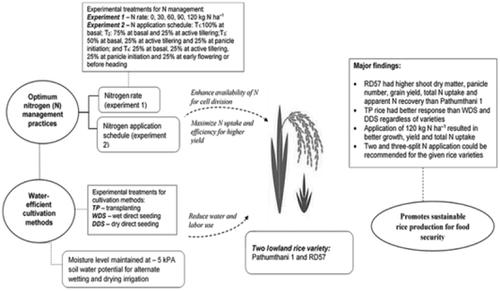当前位置:
X-MOL 学术
›
Ann. Appl. Biol.
›
论文详情
Our official English website, www.x-mol.net, welcomes your feedback! (Note: you will need to create a separate account there.)
Nitrogen fertiliser and establishment method affect growth, yield and nitrogen use efficiency of rice under alternate wetting and drying irrigation
Annals of Applied Biology ( IF 2.6 ) Pub Date : 2020-03-05 , DOI: 10.1111/aab.12585 Raquel Santiago‐Arenas 1 , Buyung A. Fanshuri 1, 2 , Sholih N. Hadi 1, 2 , Hayat Ullah 1 , Avishek Datta 1
Annals of Applied Biology ( IF 2.6 ) Pub Date : 2020-03-05 , DOI: 10.1111/aab.12585 Raquel Santiago‐Arenas 1 , Buyung A. Fanshuri 1, 2 , Sholih N. Hadi 1, 2 , Hayat Ullah 1 , Avishek Datta 1
Affiliation

|
Sustainable rice production through selection of best suitable cultivar, water‐efficient crop establishment method and optimum nitrogen (N) management practice is needed to feed the growing world population. Two polyhouse experiments were conducted to evaluate the response of rice to different rates and schedules of N application under different establishment methods subjected to alternate wetting and drying (AWD) irrigation. In the first experiment, the response of two rice cultivars (Pathumthani 1, RD57) under three establishment methods (transplanting [TP], wet direct seeding [WDS], dry direct seeding [DDS]) and five N rates (0 [N0], 30 [N30], 60 [N60], 90 [N90], 120 [N120] kg ha−1) was evaluated. The second experiment consisted of the same cultivars and establishment methods, but with four N application schedules (T1: 100% at basal; T2: 75% + 25% at basal and at active tillering, respectively; T3: 50% + 25% + 25% at basal, at active tillering and at panicle initiation, respectively; and T4: 25% + 25% + 25% + 25% each at basal, at active tillering, at panicle initiation and at early flowering or just before heading starts) applied at the rate of N60 kg ha−1. Plants were maintained under AWD irrigation (soil was saturated by applying water whenever soil water potential drops to −5 kPa during the implementation period) in both experiments. RD57 performed better than Pathumthani 1 having higher shoot dry matter, panicle number, grain yield, total N uptake and apparent N recovery efficiency. TP gave better response than WDS and DDS regardless of cultivars. Application of N120 resulted in better growth, yield and its components and total N uptake regardless of establishment methods and cultivars. Increasing N rate decreased N use efficiency (NUE). Scheduling the interval of N application to two or three times (T2 or T3) for RD57 and Pathumthani 1, respectively, provided overall better results, and could be recommended for the tested rice cultivars. An optimal N rate and selection of critical growth stages for N application would be very effective for maximising yield and NUE under the water‐saving cultivation technique of AWD irrigation.
中文翻译:

交替干湿灌溉条件下氮肥和氮肥的形成方法对水稻的生长,产量和氮素利用效率的影响
需要通过选择最合适的品种,节水作物的建立方法和最佳的氮(N)管理实践来实现水稻可持续生产,以养活不断增长的世界人口。进行了两次温室试验,以评估水稻在不同的湿润和干燥(AWD)灌溉条件下,在不同的建立方法下对不同施氮量和施氮时间表的反应。在第一个实验中,两个水稻品种(Pathumthani 1,RD57)在三种建立方法(移植[TP],湿式直接播种[WDS],干式直接播种[DDS])和五个氮素比率(0 [N 0 ]下的响应],30 [N 30 ],60 [N 60 ],90 [N 90 ],120 [N 120 ] kg ha -1)进行了评估。第二个实验由相同的品种和建立方法组成,但有四个氮素施肥计划(基数为T 1:100%;基till分active为T 2:75%+ 25%;分till活动为T 3:50%+在基础上,主动分till时和穗开始时分别为25%+ 25%;在基础上,在主动分till时,在穗开始时以及在早期开花或刚开花时,T 4分别为25%+ 25%+ 25%+ 25%+ 25%在开始抽穗之前)以N 60 kg ha -1的速率施用。在两个实验中,将植物维持在AWD灌溉下(在实施期间每当土壤水势下降至-5 kPa时,通过浇水使土壤饱和)。RD57的表现优于Pathumthani 1,具有较高的茎干物质,穗数,籽粒产量,总氮吸收量和表观氮回收效率。不论品种如何,TP的响应均优于WDS和DDS。施用N 120导致更好的生长,产量,其组成和总氮吸收量,而与建立方法和品种无关。氮肥利用率的提高降低了氮肥的利用效率(NUE)。将N应用的间隔安排为两次或三次(T 2或T 3)分别对RD57和Pathumthani 1提供了更好的总体结果,并且可以推荐用于受试水稻品种。在AWD灌溉的节水栽培技术下,最佳氮肥施用率和选择关键的生育期对最大化产量和NUE非常有效。
更新日期:2020-03-05
中文翻译:

交替干湿灌溉条件下氮肥和氮肥的形成方法对水稻的生长,产量和氮素利用效率的影响
需要通过选择最合适的品种,节水作物的建立方法和最佳的氮(N)管理实践来实现水稻可持续生产,以养活不断增长的世界人口。进行了两次温室试验,以评估水稻在不同的湿润和干燥(AWD)灌溉条件下,在不同的建立方法下对不同施氮量和施氮时间表的反应。在第一个实验中,两个水稻品种(Pathumthani 1,RD57)在三种建立方法(移植[TP],湿式直接播种[WDS],干式直接播种[DDS])和五个氮素比率(0 [N 0 ]下的响应],30 [N 30 ],60 [N 60 ],90 [N 90 ],120 [N 120 ] kg ha -1)进行了评估。第二个实验由相同的品种和建立方法组成,但有四个氮素施肥计划(基数为T 1:100%;基till分active为T 2:75%+ 25%;分till活动为T 3:50%+在基础上,主动分till时和穗开始时分别为25%+ 25%;在基础上,在主动分till时,在穗开始时以及在早期开花或刚开花时,T 4分别为25%+ 25%+ 25%+ 25%+ 25%在开始抽穗之前)以N 60 kg ha -1的速率施用。在两个实验中,将植物维持在AWD灌溉下(在实施期间每当土壤水势下降至-5 kPa时,通过浇水使土壤饱和)。RD57的表现优于Pathumthani 1,具有较高的茎干物质,穗数,籽粒产量,总氮吸收量和表观氮回收效率。不论品种如何,TP的响应均优于WDS和DDS。施用N 120导致更好的生长,产量,其组成和总氮吸收量,而与建立方法和品种无关。氮肥利用率的提高降低了氮肥的利用效率(NUE)。将N应用的间隔安排为两次或三次(T 2或T 3)分别对RD57和Pathumthani 1提供了更好的总体结果,并且可以推荐用于受试水稻品种。在AWD灌溉的节水栽培技术下,最佳氮肥施用率和选择关键的生育期对最大化产量和NUE非常有效。



























 京公网安备 11010802027423号
京公网安备 11010802027423号